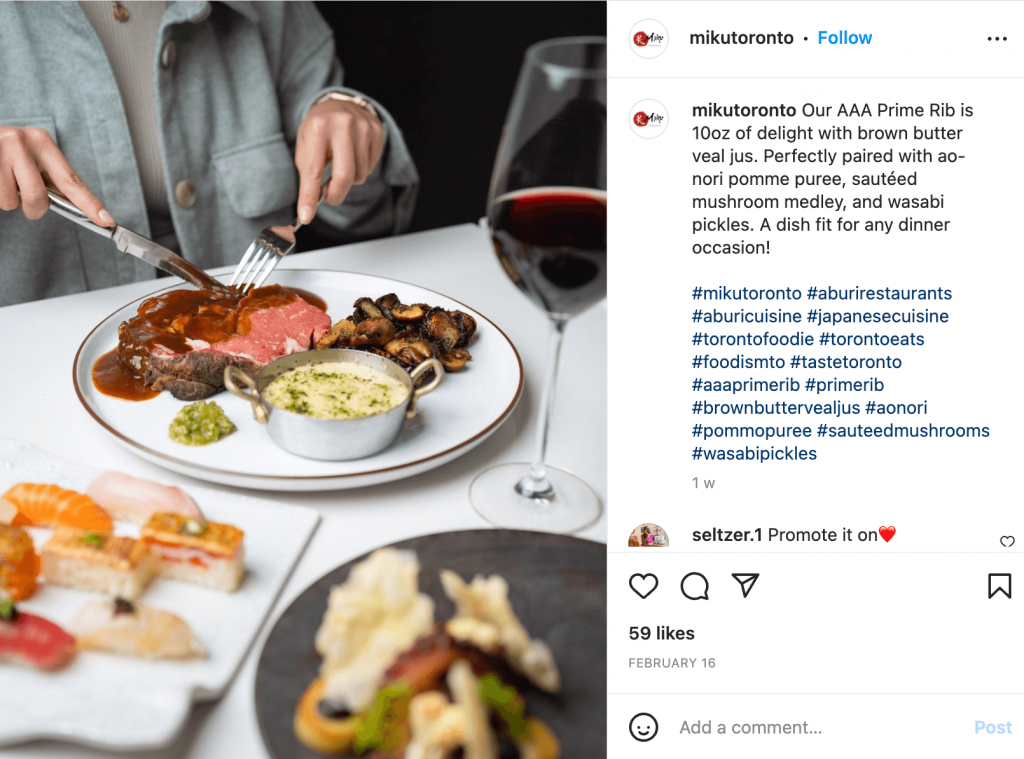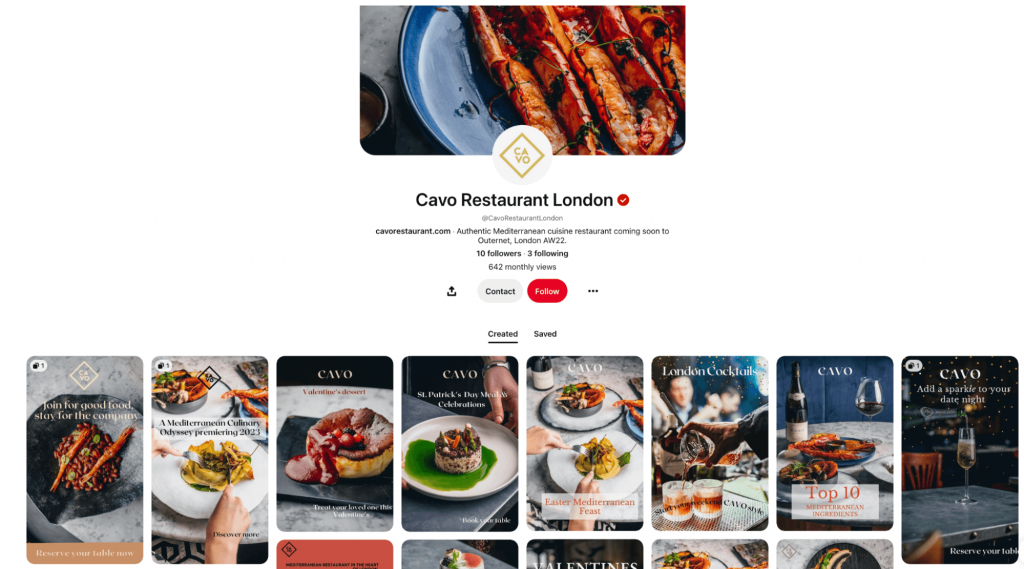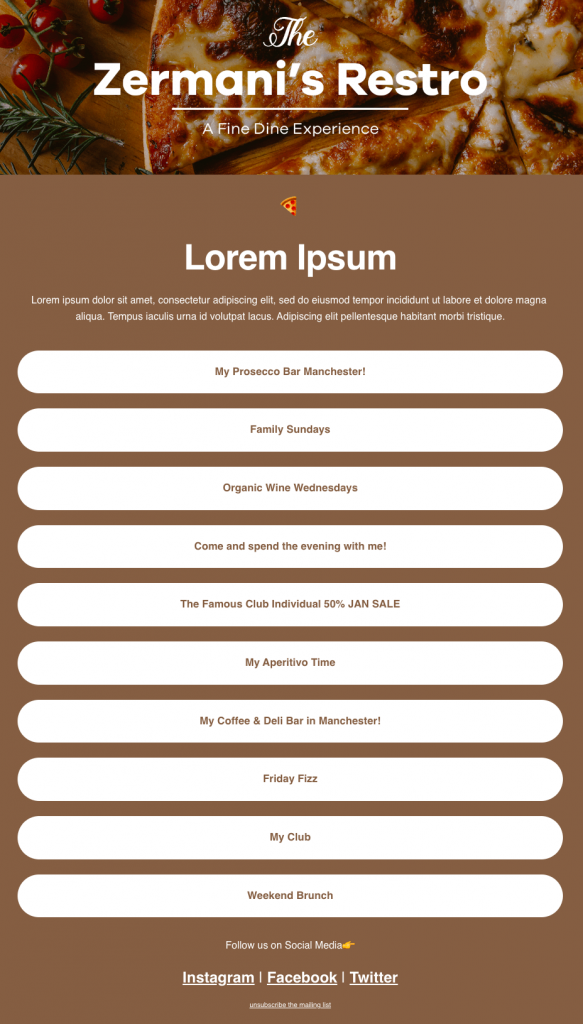You’ve just opened your restaurant and you want to get the word out. Or you’re counting the days until launch, but you don’t want to wait until then to start generating some buzz.
Where would you head first?
To social media, most likely.
Social media has proven to be both an incredibly powerful and cost-effective tool for restaurant marketing. And today, we’ll show you some trusted tactics you can use to get the most out of social media for your restaurant.
How does social media marketing help restaurants?
#1 Building a strong brand image
With social media, restaurants have the opportunity to showcase their food and atmosphere in real-time. Through photos, videos, and customer reviews, diners can get a better feel for your establishment before they step inside.
A solid social media presence builds trust with potential customers and increases brand awareness, which translates into more visits to your restaurant.
#2 Connecting with customers
Want to get feedback on your restaurant? Its social media profiles make it easy. You can ask customers what they think of your offer, pricing, or service.
This allows you to understand how people perceive your establishment and make any necessary changes to improve the customer experience – even before they actually knock on your restaurant’s door.
#3 Improving customer service
Booking tables, taking delivery orders, and responding to customer inquiries can be time-consuming – especially if you run a chain of restaurants, or if your restaurant is busy (on top of that).
Social media can streamline these processes for you and your staff, making it easier to deliver better customer service and create a more satisfying experience for your clients.
#4 Creating a solid marketing channel
Restaurant social media accounts can form a so-called tube for your restaurant’s marketing and advertising efforts. Whether it’s a special event, promotion, or new menu item – social media is the perfect platform to spread the word about it.
And it’s social media channels that people will often turn to first when they want to find out more information about your restaurant. That gives you another reason to keep your socials up-to-date when managing a restaurant business.
#5 Targeting a precise group
Many local restaurants are rather small, but you can expand your reach beyond your area with the aid of social media. You can leverage social platforms to target people from a specific demographic or geographic region who are more likely to become customers.
Or, you can capitalize on being a local business and focus on building relationships with the local community in your city or district. Both tactics work.
What social media platforms are best for restaurants?
With a plethora of available social media platforms, it can be difficult to decide which ones are the best for restaurant social media marketing. We’ve decided to divide the most popular social media platforms into three categories, which are applicable both for big restaurant chains and smaller, family-like businesses.
Love it or hate it, Facebook still is the biggest social media platform out there. You can use it to post updates about your restaurant, highlight specials and events, run ads targeting social media users in your area, and much more.
It’s powerful for restaurant social media marketing, because:
- It offers an advanced ads manager (Meta Business Suite) that you can use to target the exact people who are most likely to become your customers based on their interests and location/
- It allows you to post various types of content, from photos and videos to stories and even long-form storytelling posts/
- It’s still often the go-to platform, especially for older generations who often don’t use other platforms as much as teens and young adults.
Known as an incredibly visual platform with a still-growing user base, Instagram is perfect for restaurants that plate up photogenic dishes or have nice environments. Use it to share pictures of your food, drinks, staff members, and any other exciting content relevant to your restaurant marketing strategy.
It’s powerful for restaurant’s social media strategy, because:
- It has a lot of built-in engaging formats (like story posts, carousel posts etc.).
- It’s a very mobile-oriented platform, which means that it’s great for reaching out to social media users on-the-go.
- It allows you to use hashtags and location tags that allow you to connect with potential customers in your area.
X
Used by millions of people every day, X is a solid platform to stay connected with customers and build relationships in specific locations. Areas like the US or the UK, where X is especially popular, can benefit most from this platform.
It’s powerful for social media campaigns for restaurants because:
- It allows you to post updates frequently, which keeps your customers in the know about what’s going on at your restaurant.
- It also lets you join conversations related to food, drinks, and other topics that are likely to be of interest to your customers.
- It encourages using hashtags that enable you to find and connect with customers in specific locations.
While not as popular as other social media sites, Pinterest is still a good platform to showcase your menu items and share recipes related to them. It’s particularly useful if you have many different types of dishes or seasonal specials that you want to highlight.
It’s powerful for social media marketing restaurant because:
- It allows you to create visually appealing boards filled with pins related to your restaurant.
- It is positioned really high in Google Images, so you have a good chance of appearing in search results if your pins are properly tagged and named.
- It makes repurposing content easy, as you can quickly create pins out of images and videos that you publish on other platforms.
YouTube
Not every restaurant needs an elaborate YouTube channel. However, if you are able to produce high-quality video content that showcases your restaurant’s dishes and ambiance, or relates to your business in another way, YouTube can both engage existing customers and attract new ones.
Adding this platform to your restaurant’s social media strategy makes sense when you have a lot of video assets ready.
It’s powerful for restaurant social media marketing plan because:
- It allows you to reach out to people who are looking for recipes or reviews of restaurants in their area.
- It often has less competition than other platforms and can be easier to reach people.
- It allows you to use effective SEO techniques and link back to your website.
TikTok
TikTok is one of the fastest-growing social media platforms out there, and it’s particularly popular among young people. Restaurants that manage to create entertaining videos can gain recognition from their target audience in no time
It’s powerful for social media for restaurants because:
- It has a very engaged user base.
- It makes creating short-form videos a breeze.
- It allows you to reach a large, mostly young audience.
User reviews network
Yelp, TripAdvisor, Google my Business. What do they all have in common? They are user review networks that allow customers to leave feedback about their experience with your business.
They’re powerful for restaurant marketing because:
- They allow you to easily monitor customer satisfaction.
- They build trust and reputation, as potential customers will be able to read what other patrons have said about your restaurant.
- They give you an opportunity to address any customer complaints quickly.
Note: these are not your regular go-to social media platforms, but they might turn out to be essential for restaurant success.
While there are plenty of other social media platforms, this set should provide you with a solid foundation for creating an effective online presence.
Social media marketing for restaurants: examples
We have the theory covered, so now let’s look at some examples of good restaurant social media strategies.
Fill out your profiles/bios
When people want to look for info about your restaurant on social media, they should be able to find it easily. Fill out all the information fields – this can be overwhelming, but try to make it as complete and accurate as possible.
Prioritize filling in information such as your location, phone number, website, and opening hours. Also include a high-quality profile picture of your restaurant or its logo so customers can easily recognize you when they come across your page.
You can use popular link-in-bio builders to include more than one link in your bio and easily direct people via one link to:
- your website
- your reservation portal
- your menu
- online delivery services
- other related content (e.g. awards or interviews)
Use social media tools to create a cohesive brand voice
Running a restaurant is no easy task, and adding a lot of marketing duties to the pot can be overwhelming. Fortunately, there are a lot of tools for creating an effective and consistent presence on social media without investing too much time.
Kontentino: your go-to tool for social media management for restaurants
Kontentino allows you to plan, schedule, and collaborate on all of your social media posts in one place. It has tons of features to get the most out of each post, such as:
- scheduling of posts across various platforms
- analytics and tracking of post performance
- approval workflows (both internal and external) to keep all content on-brand
- tags and labels for easy organization
- collaboration with team members
- content library where you can store e.g. brand guidelines and graphic design templates
Kontentino frees up time for you so you can focus on creating delicious dishes instead of worrying about posting them on social media.
Engage with users
Don’t leave a single comment or message unattended. Reply quickly to all your customers and followers who reach out. That will allow you to build relationships and foster loyalty among your audience, as well as to reach more users.
Don’t forget that social media is a two-way street – it’s an opportunity to start conversations with potential clients. For example, you can ask what their favorite dish is or what they would like to be added to your menu. Social media algorithms promote engagement, so focus on them with your social media presence.
Here’s a short list of good engagement practices you should follow:
- create polls or surveys to get feedback from customers
- ask and answer questions in the comments section of your posts
- reply to direct messages
- tag other local businesses and influencers you collaborate with in your posts (they might tag you back)
- prepare a set of templates to use for replying to customers quickly and efficiently
- say “thank you” in response to both positive feedback and negative comments (as per the LATTE rule that was invented in Starbucks) and turn unhappy customers into happy brand ambassadors
Use relevant hashtags and location tags
Especially when you are only just starting out, hashtags and location tags are the way to go to build your following on social media. The former allow you to reach those who are interested in a particular topic, while the latter give you a chance to appear in local social search results and get discovered by people nearby.
To gain more visibility and boost your reach:
- create a set of hashtags relevant to your restaurant (e.g. the type of cuisine you serve or other restaurant industry tags)
- use location pins at all times and review them regularly for accuracy (especially if you have multiple locations)
- research trending hashtags in your area and use them to further increase your visibility
- come up with an idea of a branded hashtag that your customers can use to share their experience in your venue (i.e. user-generated content that we’ll cover just a few lines down)
Leverage UGC
Speaking of user-generated content, this is one of the biggest prizes you can reap from your social strategy. Ask customers to share their photos or stories about the time spent in your restaurant and reward them with special offers or discounts for doing so.
This will create a sense of community around your restaurant business and make people feel appreciated, which is vital for successful social media marketing efforts.
There’s nothing wrong with encouraging your audience to share UGC via various incentives. Try to mix them up:
- offer discounts for tagging your restaurant
- give a free meal for those who share their photo with the highest number of likes
- suggest an upgrade on the next visit
The sky’s the limit here!
Involve influencers
Getting a lot of natural user-generated content can be extremely difficult, so why not team up with influencers? They often already have large followings and enable you to reach many more potential customers, all without spending too much money.
The numbers speak for themselves when it comes to social media influencer marketing too. Among the reasons why consumers follow virtual influencers in the United States, for 15,5% it’s “They inspire me”, for 26,6% it’s “Content”, and for 18.6% it’is “Storytelling”.
Influencers have mastered the art of storytelling and can easily transfer it to your restaurant. Just be careful to choose the right influencer who will fit in with your brand and attract the desired audience.
You can search for local influencers on platforms like Instagram, Twitter, or YouTube who fit the style and ambiance of your restaurant. Reach out to them, discuss possible collaborations and offer something in return.
Whether it’s a free meal, a discount, or even just a mention – any of these perks would be highly appreciated and contribute to you achieving your goals.
Use quality assets
Look at these two photos below. Which one stands out more?


The answer is simple: the second one is a near-perfect social media post. Why? Because the visual content is professionally made and eye-catching, thus grabbing your attention almost immediately.
The same goes for all social media marketing content. To achieve optimal results, use high-resolution images and videos that convey the vibe of your restaurant in a matter of seconds.
In addition, to keep your business profile looking consistent, use:
- the same color palette
- the same fonts on visuals
- the same set of hashtags (speaking of the main set)
- the same message for ads
- the same links (so you always know what your clients refer to)
This will help people recognize your posts right away and associate them with your brand.
Keep your social media channels updated
Still sharing a menu from 2017 in your Instagram post? Creating many Facebook posts showing outdated interiors? Well, it’s high time to change that. Keeping your social media channels up-to-date is crucial for staying relevant in the digital age.
Make yourself an SLA for reviewing all the information on each social media profile you run. Whenever the details change in real life, they have to be changed on social media profiles too.
Every month, review elements such as:
- contact details
- links to your menu
- opening hours
- special offers
Use paid promotion
Relying on organic reach in 2023 is not the best idea for restaurant marketing. To stay ahead of the competition, you must use paid promotion on social media. It will gain you more visibility and make reaching qualified leads faster and easier.
Choose platforms that your target audience mainly uses. Some advertising ecosystems, such as that by Meta, allow you to precisely target a chosen location with a pin-point accuracy. This is a method that appeals to people who live nearby and may be interested in tasting your dishes now.

Your ad spend doesn’t have to be massive. Start small with several campaigns, measure their performance, and adjust accordingly across your restaurant’s social media profiles.
Experiment with post formats
When you think about restaurant content, you might see photos and videos as the leading ones. But don’t forget about the power of words (and repurposing).
What you can post on your social media page (that’s not just another meal photo):
- long-form content
- AMA section
- discount codes redistributed in the form of Facebook page offers
- interactive posts
- online reviews repurposing
- fun trivia questions (“fill in the blanks”)
- recipe ideas
- reposting posts as Reels and Instagram Stories
- quizzes and polls
- behind the scenes content
- special events
- questions to start a conversation
To start on the right foot, look at what other restaurants in your area post about and identify any specific ideas that might work for you too. You should also look at your past activities – maybe one of your previous posts has since kicked off massively and you can repurpose it now?
You can also host social media contests.
Collaborate on giveaways with complementary local businesses
Collaborating with local businesses is a great example of how restaurant brands can enhance their social media marketing efforts. Teaming up with nearby coffee shops or florists, restaurant owners can promote events and build relationships within the community.

Use your social media management tools to schedule posts that announce giveaways, driving interest from potential guests. A paid ad campaign on a business page can extend the reach of the giveaway to other local events, increasing website traffic.
Engaging giveaways on your restaurant’s Facebook are an effective way to boost interaction with social media posts, while driving more customer data for future direct messaging opportunities.
This strategy will complement your digital marketing efforts across social platforms and attract new diners.
Create a virtual dining experience with live storytelling
One original idea that stands out in restaurant social media marketing is creating a virtual dining experience combined with live storytelling. R
ather than just posting photos of food, host a live event on a top social media platform where a chef or even a local storyteller shares the history or origin of certain dishes while cooking.
Your social media manager can promote this unique event on your Instagram account, engaging followers with teasers in the days leading up to the live event. By merging food with culture and stories, you’ll offer followers more than just visuals — you’ll give them an experience. Such an interactive event could encourage real-time participation and create deeper connections between your brand and your audience.
Make the most of marketing for restaurant social media marketing tips
No matter if you run a fast-casual restaurant, casual dining venue, fine dining restaurant, or upscale eatery, social media ought to be part of your restaurant social media marketing strategy. With so many fish in this pond, it’s not enough to post pretty pictures and hope for the best – you need a solid plan of action.
Rome wasn’t built in a day. Start small and don’t be afraid to experiment. When you gain enough experience, you’ll easily understand where your audience is, what they want, and how they prefer to interact with your brand. This will pay off by being fully booked, all tables occupied, and receiving the best reviews ever.
Bon appetite!












